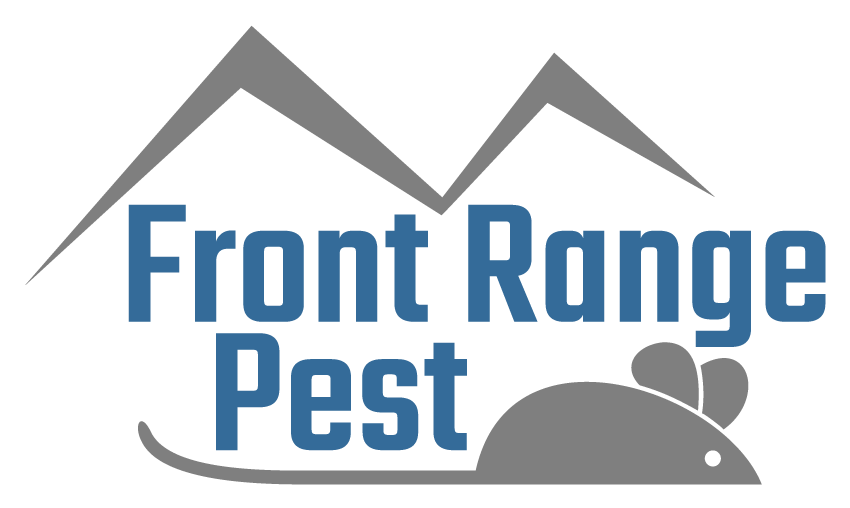Aggressive Stinging Insects

Characteristics of Wasps, Hornets, and Yellowjackets
Hornets and yellowjackets are specific types of wasps. There are about twenty different varieties of hornets and thousands of species of wasps. Hornets are typically more aggressive and rounder than other stinging insects. Bald-faced hornets are mostly black with white markings, while yellowjackets are black with yellow bands and a pinched waist. Yellowjacket stings are the deadliest as they might cause blood poisoning due to their bacteria-laced stinger. These insects will scavenge for food including other insects, spiders, picnic foods, trash, natural sugars, carcasses, and feces. Hornets and some wasps are pollinators, which means they help our ecosystem by pollinating flowers and eating other insects and pests that feed on our crops.
What are Bald-faced Hornets?
The most common wasp in Colorado and Wyoming is the Bald-faced hornet. Recognizable by the white pattern on its face, these insects are roughly three-quarters of an inch long. Bald-faced hornets are typically more aggressive than other types of wasps and yellowjackets. They might sting without provocation and can sting repeatedly. Trees and bushes are their primary nesting habitat in rural and urban locations. Bald-faced hornets make paper-like nests from wood fibers and saliva. These hives can grow to extreme sizes, sometimes swelling larger than an average football. People should not attempt to remove these nests due to the inherent danger of doing so. Only a pest control specialist trained and equipped to safely and efficiently remove bald-faced hornet nests should approach a colony.

What are Yellowjackets?
Yellowjacket dispositions are vast, as different kinds have varying behaviors and hive types. For example, common yellowjackets build small, wide, flat, and open-celled hives under overhangs. Eastern yellowjacket colonies, however, make their hives underground and can reach numbers as high as five thousand in a single hive. German yellowjackets are typical in Colorado, Wyoming, and the entire U.S. They build massive, intricate hives in wall cavities and ceilings, which can reach twelve feet in length. They are most commonly found in vertical sections of drywall underneath attic insulation.
When provoked, yellowjackets become highly aggressive and can be unpredictable. They have painful stings and can carry anaerobic bacteria on their stingers, picked up from frequent visits to landfills, sewage puddles, or damp manure. Sometimes, stings can be deadly due to blood poisoning or allergic reactions. Only a pest control specialist trained and equipped to safely and efficiently remove yellowjackets is recommended.
Removing Stinging Insects
Eradicating a stinging insect hive is possible in most cases; other times require deterrence. Knocking down a bald-faced hornet hive or exterminating a yellowjacket nest may be reasonably simple to accomplish; however, doing so sting-free may be another story. Oftentimes, stinging insects will rebuild and repopulate a hive in the same location just a few days later. There is no guarantee that eaves cleared of wasp nests will not be settled by new colonies later in the season. A pesticide gas should be used to reach yellowjacket hives that have been built inside brick and would otherwise be inaccessible due to conventional sprays.
Front Range Pest is a licensed pest control company, certified, extensively trained, and equipped to safely and efficiently remove stinging insect hives. Don’t put yourself or others at risk attempting to remove a colony of aggressive wasps; leave it to the pros!
Seek Medical Attention for Severe Life-Threatening Stings!
Symptoms usually involve multiple body parts, such as the skin, mouth, lungs, heart, stomach, and intestinal tract. When in doubt, call 911 for any medical emergencies. Anaphylaxis symptoms include:
- Skin rashes, itching, or hives
- Swelling of the lips, tongue, or throat
- Shortness of breath, trouble breathing, or wheezing
- Dizziness or fainting
- Stomach pain, vomiting, bloating, or diarrhea
- The general feeling that something bad is about to happen
Treatment and Remedies for Non-Life-Threatening Stings
If you or someone you know has been stung and no anaphylaxis symptoms are present, follow these steps to remediate the situation:
- Check to see whether the stinger is still in the skin. Wasps typically only leave their stingers behind if they are swatted and the stinger breaks off in the skin. If the stinger is present, remove it with tweezers.
- Cover the affected area with wrapped ice or pre-packaged frozen food. To avoid ice burn, do not put ice directly on the skin. Leave the ice in place for five minutes to reduce blood flow. This also slows the defensive reaction of the body against the venom.
- Ibuprofen, Benadryl, or acetaminophen can help reduce pain. Calamine lotion applied to the affected area throughout the day decreases itching. Scratching the affected area will result in the spread of the venom, thus lowering the healing process.
Avoid endangering yourself or others by trying to remove a hostile wasp colony – Our team is highly trained and equipped to eliminate aggressive insect hives safely.
__________
Front Range Pest is a local, family-owned, and operated pest and wildlife control company serving central Colorado and southern Wyoming. Our techs are licensed, insured, and certified with the proper credentials to provide effective pest management for your home or business. As your trustworthy, all-inclusive insect and wildlife specialists, we provide peace of mind by tracking wildlife entry points, removing nuisance pests, properly sealing access areas, cleaning up, and making necessary repairs. Contact us today to schedule an inspection.
Written by the digital marketing team at Creative Programs & Systems: https://www.cpsmi.com/
